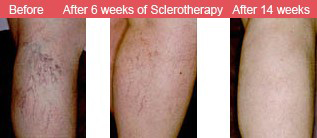Sclerotherapy

Sclerotherapy is a minimally invasive medical procedure used to treat varicose and spider veins, most commonly found on the legs, by collapsing them through the use of a solvent. Sclerotherapy has been used on patients since the 1930s with great success, producing increasingly effective medical, as well as cosmetic, results.
Reasons for Sclerotherapy
Individuals troubled by varicose veins, either because they find them unattractive or because the diseased veins are causing unpleasant and/or dangerous symptoms, such as leg pain, cramping and difficulty standing for any length of time.
Procedure of Sclerotherapy
 During sclerotherapy, a solution of saline and a sclerosant is injected into the damaged veins. This will cause irritation in the affected veins and produce their eventual collapse. During this procedure, the surgeon is guided through the use of ultrasound to ensure precision. When the weakened veins collapse, they will be reabsorbed into the body and other healthier veins will take their place in the circulatory system. The procedure usually takes less than an hour, but the patient may require more than one treatment. Some bruising is to be expected after the procedure, but usually resolves quickly.
During sclerotherapy, a solution of saline and a sclerosant is injected into the damaged veins. This will cause irritation in the affected veins and produce their eventual collapse. During this procedure, the surgeon is guided through the use of ultrasound to ensure precision. When the weakened veins collapse, they will be reabsorbed into the body and other healthier veins will take their place in the circulatory system. The procedure usually takes less than an hour, but the patient may require more than one treatment. Some bruising is to be expected after the procedure, but usually resolves quickly.
Risks of Sclerotherapy
Although sclerotherapy is a safe procedure, there are certain risks associated with any medical procedure. Complications are rare, but may include:
- Inflammation
- Blood clot, or thrombosis
- Nerve damage
- Adverse reaction to sclerosant.
Recovery from Sclerotherapy
Patients are able to return home shortly after sclerotherapy. Most can return to work and resume normal activities the next day, although exercise and strenuous activities are to be avoided a week or two. Compression bandages usually need to be worn for a week after the procedure. Some improvement is usually visible immediately.
It is recommended that patients maintain a healthy weight and make exercise part of their daily routine to promote vascular health and to preserve the positive effects of the sclerotherapy.
